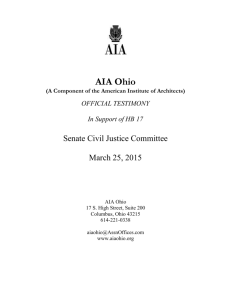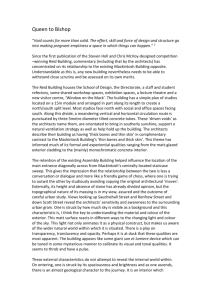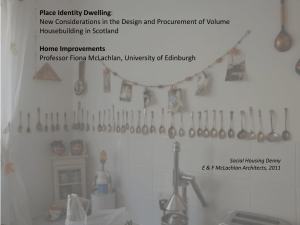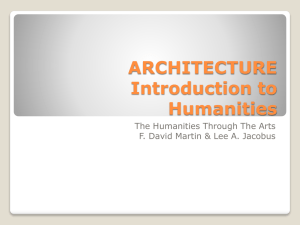Ethnography Final draft
advertisement
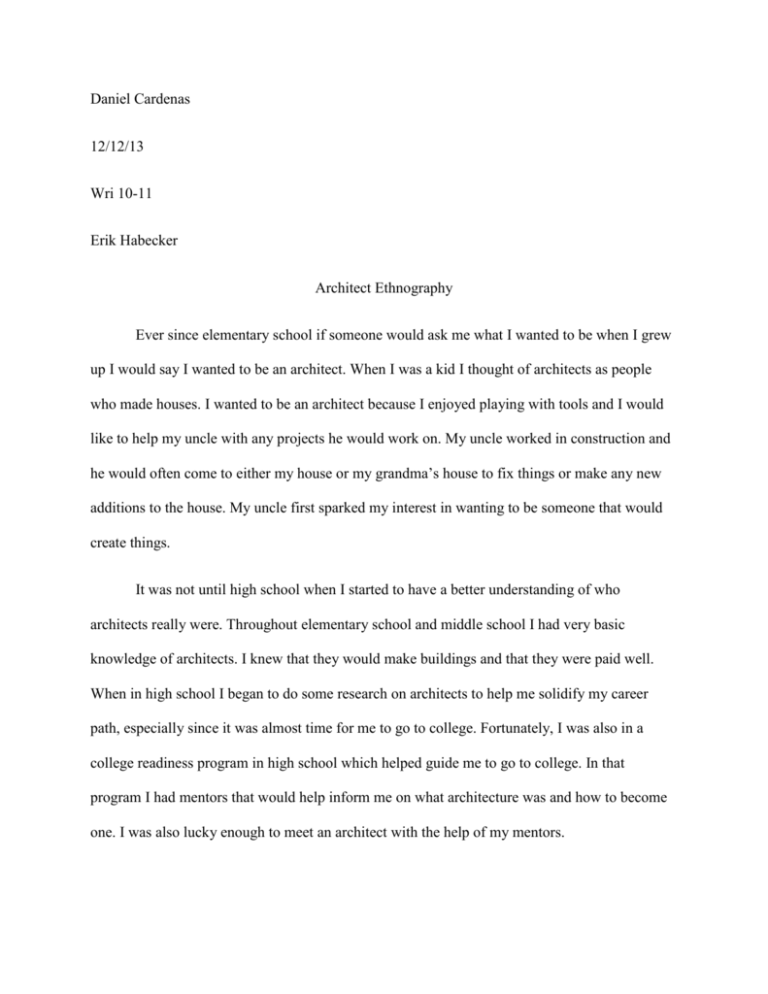
Daniel Cardenas 12/12/13 Wri 10-11 Erik Habecker Architect Ethnography Ever since elementary school if someone would ask me what I wanted to be when I grew up I would say I wanted to be an architect. When I was a kid I thought of architects as people who made houses. I wanted to be an architect because I enjoyed playing with tools and I would like to help my uncle with any projects he would work on. My uncle worked in construction and he would often come to either my house or my grandma’s house to fix things or make any new additions to the house. My uncle first sparked my interest in wanting to be someone that would create things. It was not until high school when I started to have a better understanding of who architects really were. Throughout elementary school and middle school I had very basic knowledge of architects. I knew that they would make buildings and that they were paid well. When in high school I began to do some research on architects to help me solidify my career path, especially since it was almost time for me to go to college. Fortunately, I was also in a college readiness program in high school which helped guide me to go to college. In that program I had mentors that would help inform me on what architecture was and how to become one. I was also lucky enough to meet an architect with the help of my mentors. Cardenas 2 Even though I had the privilege to meet an actual architect in his home, I still did not have a complete accurate view on what life was as an architect. When I was applying to colleges I was still determined to be an architect. Once I found out that all the colleges I applied to that had schools of architecture rejected me, then I had to change my career choice completely. I always wanted to be an architect, but I also always had an interest in engineering. I knew engineering also had to do with designing things, especially civil engineering. Now that I am studying to become an engineer I still want to find out how my life would be now if I was an architecture student and also if I actually became an architect. What might also be beneficial would be if I did a bit of separate research on engineers. That way I can see how the two professions compare and differ especially since I do not know everything about being an architect or an engineer. I have a better understanding on how architects live their daily lives. At the moment I only know that there are different types of architects, but they all design mainly buildings, but their designing is not only limited to buildings and houses. Some of the assumptions I have and most other people also have is that architects are successful, creative, independent, and that there are not many of them. The fact that there are not that many architects will make my research harder to do. I still want to research architects so I can see for myself how they really are both in the workplace and maybe even in their personal life. I will compare architects and engineers and by the end of this ethnography I will hopefully find out it was best for me to be an engineer anyways, or I might have to try to become an architect instead of an engineer. Either way architects still interest me, but my views of them will change by the end of my research process. Cardenas 3 One of the best ways for me to find out more about architects is to physically meet them and the most important place for architects is probably their own home. Most architects make a living designing homes and buildings, so their home must be their most important project. When architects talks about their own home they usually take pride and are very informed to answer anything about it. When I visited an architect’s home I was intrigued and I knew I was in the right place the moment I saw it. From the moment I pulled up to the driveway I knew that the house was the one of the architect I was meeting. It was located in a normal residential neighborhood in Venice, California. Most houses on the block were typical homes. No house was out of the ordinary. Most houses looked the same, but there was one that seemed way out of place. The first thing I saw from the driveway was a tall bamboo plant, and behind it I saw a house primarily made of glass. The first thing I thought was the saying “people in glass houses shouldn’t throw stones”. Then I also started to think why this guy would make his house with glass walls. I was only thinking of the little privacy he had and the danger of glass breaking. When I finally got to enter the house I got to meet Tony, the home owner and architect, but before I had to take off my shoes. I was never accustomed to not having shoes indoors so that was all together a new experience to me. Then what I saw that inside there was a lot of open space. The first floor seemed almost like just one big room with a kitchen and a living room. Mostly every material that made up the house had a very plain color and it was very quiet. The floor was concrete, the interior walls and ceiling were made up of a light brown wood, and there were many steel pillars and supports throughout the first floor. What brought color to the house Cardenas 4 was the furniture. I could see bright orange stools in the kitchen, white chairs in the dining room, and rustic paintings on the wall. What also brought bright color were blooming cherry trees separating his home from the neighbors. The house itself seemed very modern and plain. The furniture was also modern, but it filled the room with life and color. I saw the majority of the physical things in the house, but it was not until Tony explained to me the whole message he was trying to convey in his house. He stated that “I wanted to make this house feel like you are not trapped indoors.” He then pointed out the bright pink cherry trees and the bamboo plant. The cherry trees brought life to the house from the outside, but the bamboo plant had a deeper personal impact on the house. The bamboo plant was actually planted when construction of the house began, so it shows for how long the house has been there. He then went on to say how he disapproved of common residential houses. He thought of them as “confined wooden boxes” people live in. With his house he decided to make it primarily out of glass to have a sense of freedom and openness. He wanted to make it feel almost as if it seemed like being outside when in his house, and most of all he did not want to feel confined in a “wooden box”. On the second floor there were still some glass walls, but there were also some skylights. There was a recreational room with a big television and two electric guitars hanging on the wall. The other thing that was interesting was that there was a glass door separating a balcony. The balcony was open and had white chairs and a white table, but what was interesting was when he actually opened the door. When he opened the glass door leading outside I felt a little of what he meant to do about the feeling of the outdoors indoors. Visually the house felt the same, but the Cardenas 5 quiet house got filled with the noise of oncoming cars, birds chirping, and dogs barking. In the bedroom there was a big bed with bright orange sheets, and bright white lamps on black night stands. I even caught a glimpse of colorful jewelry, and some actually matched the colors of the house and furniture. The bathroom was a surprise to me. I pictured a glass toilet with an all glass sink and shower, but I was wrong. The bathroom was actually fairly normal with a white porcelain toilet bowl, and a sink which basically looked like a big bowl on a table, but there were still glass walls and doors that could become opaque for privacy. In his office I thought I would find interesting things, and I was wrong again. I only saw a big desk full with papers and a computer, but I did not see a huge desk used for drawing new designs. He then went on to say how now much design is done with the computer. I imagined a large desk complete with sheets of paper, but that was not the case. From the second floor I could see out into the backyard. There was not really anything special, but there was a small tin motorhome in the back. I found it ironic how that would even be there because of the contrast with the big and modern house. Tony then said how that was where he actually lived during the construction of his home. So for some time he had to cope with a basic small motorhome, and he had to be confined to cramped living just like all the residential homes he does not like. The motorhome was small, but even the inside of that was designed by him. I did not get to see inside, so I had to take his word. The fact that he designed at least something in the motorhome probably helped him cope with the small scale accommodations he had. Cardenas 6 Visiting Tony’s house was an interesting experience. I had never seen a house drastically different compered to its neighboring houses. I also have never been in many two story houses, especially one so different and modern. I made many general assumptions when I first saw the outside of the house and then when I actually stepped inside. This experience kind of made me think that all that design with glass was unnecessary, but I did find out that the house is also very energy efficient so that brought me to think that at least more natural resources like light and rainwater are benefitted from. It was both a fun experience getting to look at an architect’s house and also to be able to talk directly to the creator. Another way architects might differentiate themselves from other subcultures is by the way they use and manipulate language. Language can be used in many different ways, whether they are used for good or bad. When I met architects in person and got to talk to them they seemed to all have similar ways of using language to communicate. They were all obviously very educated and kind judging solely by how they chose their wording. They were trying to be informative and helpful to me, but they probably speak like that to potential clients to ensure a secure agreement. Architects may genuinely be helpful and kind, but they may also be discreet salesmen. Judging from all the architects I met, and the conversations I had with them I noticed that they were all very informed, educated, and helpful. All the conversations I had were very casual, but formal language was used. Even though the language was formal the architects would not really use any of their insider language. They did not want me to feel left out and uncomfortable, Cardenas 7 but they also had to show their knowledge of the architecture field. They knew how to do their job, or at least I was convinced they knew. When I was talking to the architects I pictured myself as a potential client of theirs. Judging by the conversations I had, that would have closed the deal for me. I really did feel like I closely resembled a client. The architects were welcoming, educated, and they were open to almost any discussion. I would ask them to tell me both the good and the bad of their life and their job and they would answer honestly. They would be as open as possible and answer as truthfully as possible. I doubt that any of the architects really lied to me, but they may just be very good liars. When I was with the architects it felt really similar like if I was at a store with a salesman. Store salesmen are there to answer any questions and be as helpful and informative as possible, but their underlying goal is to obviously make a sale. With no sales then they have no job. It felt very similar with architects. They may have been genuinely informative and helpful with me since I said I was a student, but if I presented myself as a potential customer they would have probably upped the ante. With a potential client architects probably use more insider language to show their knowledge, but they still acknowledge that the person they are talking to came to them for help, not a lecture. Another thing that stood out in architects’ language is how the words are formal, but the conversation is somewhat casual. The architects are obviously college graduates so it is expected for them to keep a professional profile, but they are also human, and there is a time and place for everything. The conversations were from adult to adult. It did not feel like if they were trying to Cardenas 8 dumb themselves down for me. They saw me as equal and it showed. There was a sense of respect since they were including me completely in the conversation. I even asked what the worst part of being an architect and he answered “The worst part is the amount of work, time and energy committed to be a successful architect. It is a lot of work, but the payoff is worth it. Another bad part is that some projects never get built. An architect can spend time on a good project, but sometimes the building is never built, so it stays on paper.” That answer for me was very genuine and truthful, and that is what brought me to feel comfortable and welcome. If they wanted to overachieve and show their complete knowledge of architecture, then they would lose my attention and probably a client if I was one. One last way architects can use language is actually unintentional. When architecture students first learn about architecture they start to learn new ideas and concepts. These ideas and concepts then affect their language in minor ways. Once they become architects they start to replace words with better ones. Instead of calling a door a door they call it an entrance, and they may call a building a structure. Architects have many terminologies just like any other subculture. Some terminologies replace common words and other terminologies may just be used frequently Many people may think architects purposely use these terms to make themselves look smarter, but architects are just accustomed to those terms. Architects’ language is not very different from other subcultures, but there are small things that make it shown that an architect is speaking. Overall, I would say that architects are mostly educated and helpful people. Their goal is to make someone feel comfortable and secure in order for them to eventually get hired. Their Cardenas 9 sales pitch is very subtle, but there is always that feeling of why architects would be so nice and helpful. Architects’ goals are to gain a client, but I believe that is not their only goal. They do want a client, but they also want that client to make the right decision and eventually have their home exactly how they wanted it. Architects use language to gain clients, but also to eventually satisfy that client. Now after all the things I learned about architects I have a better understanding of what life is like being an architect and what most architects do. I had an askew mindset of what architects were before my research. I generally thought of architects as the people with the blueprints on a construction site. I thought architects only drew buildings on paper with all the measurements and then people would build it. After all that I learned I now see architects more as artists rather than designers. The reason I think of architects so much as artists now is because of the general deign scheme they follow. Most buildings today are built with weird protrusions and are made to look abstract. When the building is usually seen people think it looks modern and different, but the architect designs it that way to convey a theme. The theme may be purely geometrical or it can have an emotional tie. I am sure there are still architects that design normal homes for middle class clients, but now it seems like the majority of architects want to design a building that people will want to look at like a canvas full of modern and abstract art. I still believe that many architects are like artists, but architects have not always been like that. Long ago architects were considered innovators and inventors. Ancient architects helped form how civilization runs today. Architects invented arches. These arches were used to make Cardenas 10 bigger and stronger buildings, but they were also used on aqueducts and bridges. They improved life for people and their basic invention is still used today. Once gothic architecture started more art was included in buildings. Gothic architects created pointed arches that would support high ceilings and provide light to the inside of the building. This design was used in many churches and cathedrals. The high ceiling was unnecessary, but everyone’s goal was to build higher and higher. They took advantage of the huge open spaces by adding stained glass windows so bible stories could be shown in an artistic manner, and the ceilings would be painted with saints and cherubs. Once gothic architecture started I believed that it started to make more architects have artistic designs. Fortunately there are still architects today that design in a more normal matter. I have met and learned about architects that design normal homes for new neighborhoods, and others that design for specific people’s needs. There are architects that help cities with underprivileged families by developing safe and practical neighborhoods. There are also architects that help the handicapped with universal design. Universal design basically makes homes accessible to anyone. These architects make it their mission to help the handicapped and the elderly live in their homes with no worries. Unfortunately these architects are not heard of very much. Most of the attention goes to the new architects with modern and abstract creations. Architects may seem more like artists, but they will always be needed even in today’s society. One of the main purposes for architects in the last few years is to define their culture. There have been many architects over time that have designed many landmarks, such as the pyramids, the Eiffel tower, and the twin towers memorial. These examples are all public spaces Cardenas 11 and even Morgan said “The best part for me is being able to create public spaces that impact people and they become a part of people’s lives.” With architects we can define many events and accomplishments visually and they will hopefully withstand the test of time. I believe both artistic and practical architects need to exist, but there are very few that design something that becomes a part of our history and culture. I believe that many architects are designing in bizarre and new ways to hopefully leave their mark in society and then make themselves known because of their building. The whole reason I chose to research the subculture of architects was because I always wanted to be an architect ever since I was a kid. Now that I know much more about architects I have reached my verdict. I have chosen to forget all about trying to become an architect and to only focus on my current career path. The reason why I wanted to be an architect was because when I was a kid I loved to play around with tools and help as much as I could. That then evolved to wanting to create things that would be new and would help people in their daily lives. In high school I would love to watch documentaries where people come up with creations that help solve a major problem, whether it be needed or not. If I become an architect I do not think that would ever be possible for me. One of the primary reasons I do not want to be an architect anymore is because I do not see the challenge in becoming one. The only challenge I see is coming up with creative designs. Whenever I try to make something or fix something I come up with creative ways to do it as easily as possible, but I am definitely not artistic. Now when I think of architects I think of artists. The only difference is that they have a whole building or plot of land as a canvas. I also Cardenas 12 do not see architecture as a challenging career path. Not much complex math is involved when becoming an architect. All of that knowledge is dropped on the engineers working with the architect. I see architecture as a profession where the amount of money the architects earn does not reflect the amount of work they put in. If I were to become an architect I would also be stuck doing almost the same thing for the rest of my life. There is very little flexibility on what can be done as an architect. Architecture is monotonous, but engineering is probably the most dynamic and flexible career. Engineering can open many opportunities. I could end up working with architects on houses or even with NASA on their next project. With architecture I would feel tied down to one thing. My life goal is to eventually be a part of something extraordinary. I want to help improve people’s lives. Architects can help people, but only if they are their client. I want to create new things and work with researchers to further my education. I want a challenging career that will eventually make me be able to do good for society. I always wanted to be an architect, but I was never fully informed on what architects did. I thought architects were responsible for not only homes, but also structures like bridges. It was not until high school where I started learning that engineers were actually responsible. Then when I started college I saw the amount of math and physics needed to become an engineer. It is a lot of material to hopefully cram in four years, but I see the end result as worthy. With architecture there is way less math and physics and more conceptual material. Architects may learn about different types of design and how to mimic it followed by basic structural engineering. That is good, but they are limited to designing static structures. If architects had to Cardenas 13 learn more math and science, then I would consider architects to be more like designers instead of artists. Architects were a very interesting and eye opening subculture to research. I went in to researching knowing the bare minimum about architects. I saw how their process of education prior to becoming architects would be like, and how their lives change when they officially become architects. I would see architects as people that would spend much of their time alone making calculations and then drawing them on blueprints. That idea was quickly forgotten once I started researching. I found out how all architects never work alone, because it would be impossible. They need a crew of engineers, inspectors, and of course construction workers. The architect is the main leader, but I do not think the architect contributes the most important work. I see architects like the creative side of a project and the engineers as the brains. Everything would be fine if only engineers were in charge, but all buildings would look almost identical. Architects are not highly important for me anymore, but they do contribute to society by working in harmony with engineers. If architects were solely in charge then the building would probably not stand for long, but if engineers were then buildings would be dull. Architects now provide more of a spiritual and artistic importance to society. People love to see beautiful and different houses and public spaces they could only dream of being able to live in and architects are responsible for that. The subculture of architects runs very normally and efficiently. Architects are not geniuses, but they are close when it comes to design. Painters are skilled by using paint and a canvas. Architects are artists under the category of buildings. Architects are responsible for Cardenas 14 physically appealing homes. Their profession does not seem rigorous to me, but I understand how it can be. Architects have to design a building where people could actually live. Then they have to make it look different. They can borrow different ideas from other architects, but it is difficult to be completely unique. Many things are taken into consideration when architects work on a project and sometimes they have to let go of things they wanted to include on a project. I do not see architects as useless in society, but unfortunately I think it would be best for me if I leave the profession of architecture to those that appreciate it more.
